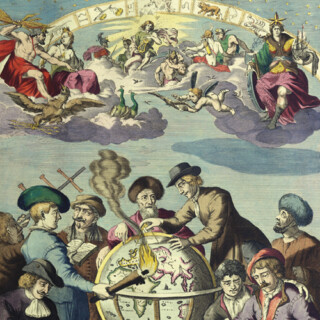Glossary of Terms for Collectors of Rare Maps, Atlases, Books, Globes and other related Scientific Objects.
A manuscript or book embellished with decorative elements that are typically hand-painted in rich colours and are sometimes gilded. The elements may include initial letters, designs, and/or pictorial scenes. French: Enluminure The quality of the ink on a map or print or all the copies of a book printed during one press run. During the handpress period, when type was reset each time a press was used, this term was synonymous with edition. French: Tirage When used as a noun refers to the publication data located at the base of a title page, usually includes the city of publication, name of the publisher (sometimes the printer), and the year of publication. Sometimes this information is located in a colophon at the back of a book. Imprint can also be used to refer to a printed piece from a certain location or period of time. Anything printed during the fifteenth century, the first century of printing with "moveable type"; from the Latin, meaning "from the cradle"; can also be used in a relative sense to refer to other early printings, i.e. Incunable lithograph. A book, or other printed piece, with a handwritten and signed statement usually written for a specific named person(s) and often located on the end paper or title page; when "inscribed" is used to describe a book, unless otherwise stated, it is implied that the author has written the inscription. When used to designate the recipients of a book as a gift from the author (or publisher), it is called a "presentation inscription". The term intaglio comes from the Italian word intagliare, meaning “to incise.” In this technique, acid or a pointed tool is used to incise the composition into a metal plate, usually made of copper, but sometimes of steel, iron or zinc. After the image has been drawn, the plate is covered with ink, and then wiped so that only the incised areas contain ink. The pressure of the press forces the paper into the incisions where they pick up the ink, resulting in the raised character of the lines on the impression. Because often the sheet of paper is larger than the plate, an indentation of the plate edges, or platemark, appears around the edges of the image area. Before steel facing, a plate, especially one containing drypoint lines, would degrade over time as the pressure of the press would dull the burr. As a result, the first impression was often crisper than the last. The different types of intaglio prints are distinguished by the technique used: etching, aquatint, and photogravure are made using acid to corrode the metal plate, while engraving, drypoint, and mezzotint are made using a sharp tool to incise, or scratch, the surface of the plate. Often several different intaglio techniques are used in the same print to achieve variations in contrast and tone. A portion of an edition printed or published deliberately by the printer or publisher in a distinct form differing from the rest of the printing relative to paper, binding, format, etc. The distinction between "issue" and "state" is that the former relates to changes done on purpose by the publisher and intentionally treated as a separate unit, i.e. a large paper issue.
Glossary
I
Illuminated
Illuminated
German: Illuminiert
Impression
Impression

Imprint
Imprint

Incunable
Incunable

Inscribed
Inscribed

Intaglio printing
Intaglio printing

Issue
Issue







